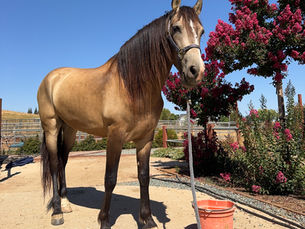Hoof Abscesses: Everything You Need to Know
- Horse Education Online

- Feb 20
- 6 min read

What is an abscess, and what causes it?
Abscesses happen when bacteria invade the sensitive sole through a puncture wound, a compromised area of the hoof, or some other trauma.
The bacteria causes cells to die, which leads to the releasing of fluid, white blood cells and inflammatory mediators. All of these substances accumulate at the trauma center to fight the bacterial infection. This becomes a pocket of fluid inside the hoof, which is our abscess.
Why is it so painful?
A horse with an abscess will be suddenly and severely lame. The reason why abscesses are so painful has to do with the properties of fluids, specifically, the fact that fluids cannot be compressed.
If you fill a balloon with water and press on it, the ballon will change shape, but it will not get smaller. This is because fluids can be displaced, but not compressed.
Another example would be a sealed syringe: no matter how hard you press on the plunger, it will not move. If you press hard enough, the syringe will break at its weakest point.
Now, picture the fluid from an abscess inside the horse’s foot: every step will put an immense amount of pressure on it. Because fluids do not compress and can only be displaced, that pressure is transferred onto the surrounding sensitive tissues.
As the fluid attempts to spread, it tears the connection between sensitive and insensitive structures around it. In humans, this is akin to a blood blister under your fingernail you may get after hitting your finger with a hammer: if you push on the nail, it hurts, and it hurts because in an attempt to expand, the blood fluid tears more of the tissue that holds your nail in place.
How can it be resolved?
Much like in the case of the sealed syringe, the fluid will follow the “path of least resistance”, and will try to find an exit through the nearest weak spot of the hoof.
As soon as the liquid finds an exit and drains from the hoof, the horse will experience relief.
This can happen in several locations: an abscess can drain from the white line (point of attachment between hoof wall and sole), the back of the frog, any damaged area of the sole, and sometimes even from the coronary band, if the path of least resistance is upwards rather than downwards.
While abscesses can resolve themselves on their own, a farrier or veterinarian may be called to drain the fluid manually.
This involves the use of hoof testers, and sometimes radiographs, to determine the location of the abscess. Once the location has been identified, the farrier or veterinarian will cut into the hoof to establish drainage.
This is done to provide relief to the horse faster without having to wait for the abscess to pop on its own.
If you call your farrier to drain an abscess, ensure your horse is up to date on the Tetanus vaccine.
Once the abscess drains, whether naturally or with the help of a professional, the foot must be tended to to ensure that any remaining fluid can drain, and to prevent further infection.
Aftercare
Once the abscess has drained, the hoof will begin repairing itself. In a solear abscess, for example, a new layer of solear cells is produced every eight hours. It’s important to protect the abscess tract, wherever it may be, from new bacterial invasion.
A disposable diaper is an excellent method of keeping a foot clean.
Wet the diaper with some providone-iodine (betadine) and apply it to the hoof
Secure the diaper with vet wrap
Secure the vet wrap with duct tape
Use plenty of duct tape on the bottom of the diaper to prevent wear. Do not wrap the vet wrap or duct tape too tight around the fetlock.
If the horse does not show significant improvement within three days, call your veterinarian for a workup.
Chronic Abscesses
Occasionally, abscesses can be caused by internal hoof problems.
Septic Pedal Osteitis
An infection of the coffin bone, formally called “septic pedal osteitis”, will cause chronic abscessing. This requires veterinarian attention and drug therapy.
Bone Sequestrum
A “bone sequestrum” is a small piece of detached coffin bone. The piece of detached bone dies, and causes chronic abscessing. This required veterinarian treatment.
Keratoma
A keratoma is a slow-growing tumor of the hoof wall. Keratomas can cause chronic abscessing, and require a veterinarian for surgery and drug therapy.
Laminitis
Horses with chronic laminitis are prone to abscess formation due to compromised blood flow and hoof wall separations which facilitates the introduction of bacteria to the hoof capsule.
Types of Abscesses
Abscesses are differentiated based on their location, and/or point of drainage.
Subsolear Abscess
Location: Beneath the sole of the hoof
Description: The abscess is located between the sensitive and insensitive sole. The sole may appear warm or have a soft spot where the abscess is pushing. This type of abscess can affect a portion of the sole or its entirety.
Submural Abscess (Hoof Wall Abscess)
Location: Within the lamina of the hoof wall.
Description: Often caused by white line disease, cracks, or trauma, wall abscesses develop between the laminae and the hoof wall. These can be particularly stubborn, as the infection may spread along the hoof wall. It can be difficult to identify the exact abscess location: radiographs may be necessary, as well as a resection of the hoof wall to establish drainage.
Subcoronary or Coronary Abscess
Location: Near or at the coronary band (the junction between the hoof wall and hairline).
Description: Sometimes called a "gravel" abscess, this type occurs when bacteria invade through cracks or separations in the hoof wall and migrate upward toward the coronary band. The infection will eventually rupture at the top of the hoof.
In the 1800s, it was believed that a small piece of rock, gravel, had migrated up the hoof wall and discharged at the coronary band. It has since been shown that no foreign material migrates up the wall, just the fluid. But we still call these types of abscess a “gravel”.
Coronary band abscesses will leave a hoof blemish: a horizontal crack called a “hoof cleft”. This crack will have to grow down the wall until it is worn away or cut away by a farrier.
Heel Abscess
Location: In the heel bulbs, or in the “seat of corn, the area between the bars of the hoof.
Description: This type of abscess is common in horses heel cracks, bar cracks, or “corns”. If exiting at the heel bulbs, it can cause swelling around that area and is often mistaken for a soft tissue injury rather than an abscess
Deep Penetrating Abscess
Location: Deep within the hoof capsule, affecting the coffin bone or internal structures..
Description: These abscesses result from puncture wounds (such as stepping on a nail) that introduce bacteria deep into the hoof. They can lead to severe infections, including septic osteitis (bone infection) or joint infections if not treated promptly.
Any foreign object pushed deep into the hoof will require a veterinarian to use radiographs to determine the extent of the damage, which structures are involved, and to remove the object.

Prognosis
Each type of abscess requires careful management, including drainage, soaking, bandaging, and sometimes veterinary intervention. The prognosis for abscesses is generally really good. Deep penetrating abscesses, as well as chronic abscesses are the kinds that more often lead to complications.
Self Assessment Test
1. Identify the type of abscess pictured in the following images.
Multiple Choice Questions
Which type of hoof abscess is commonly caused by white line disease or hoof wall cracks?
a) Subsolar Abscess
b) Wall Abscess
c) Heel Abscess
d) Bar Abscess
What is another name for a subcoronary abscess?
a) Heel bruise
b) Gravel abscess
c) Laminitic abscess
d) Sterile abscess
A deep penetrating abscess is most often caused by:
a) Bacteria migrating through the white line
b) A puncture wound that introduces bacteria deep into the hoof
c) Poor hoof trimming
d) Excess moisture in the environment
True or False
___ A bar abscess forms in the frog of the hoof.
___ Chronic or recurrent abscesses are often linked to metabolic conditions like Cushing’s disease.
___ A hoof abscess usually causes gradual, mild lameness that worsens over weeks.
Short Answer
How does a subcoronary abscess typically drain?
What are two common causes of a subsolar abscess?
Why might a laminitis-related abscess be more difficult to treat than other types?
Critical Thinking/Discussion
If a horse is repeatedly getting hoof abscesses, what factors might you investigate?
A horse steps on a sharp object and becomes severely lame. What steps should you take to assess whether it is a deep penetrating













































Comments